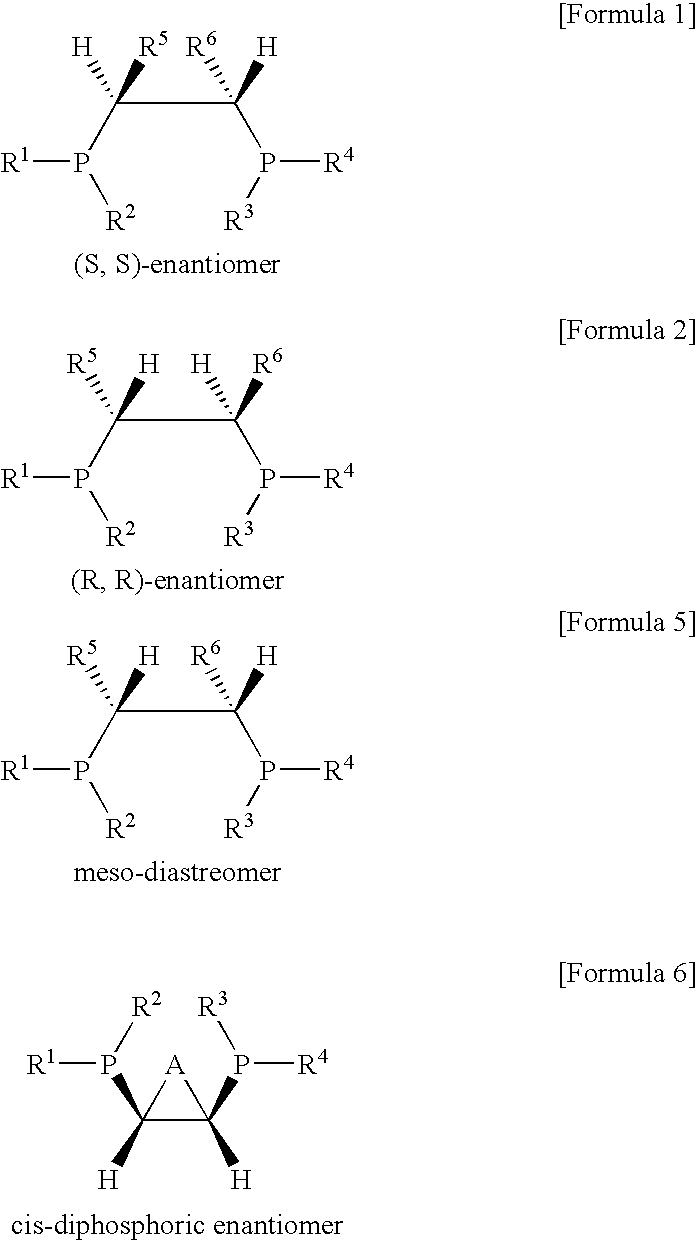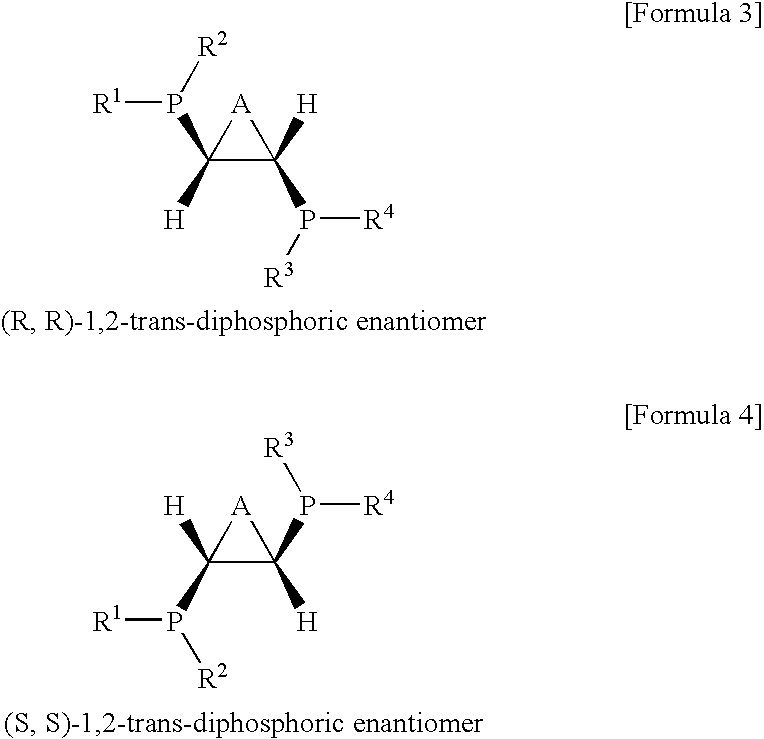Etheyene oligomeriza catalyst systems having enehanced selectivity
a technology of oligomerization and catalyst system, which is applied in the direction of hydrocarbon preparation catalysts, organic compound/hydride/coordination complex catalysts, physical/chemical process catalysts, etc., can solve the problems of inefficiency of ethylene oligomerization reactions conducted to date, limited yield of desired product, and limited possible substituents for heteroatomic ligands, etc., to achieve high selectivity, high activity, and high selectivity
- Summary
- Abstract
- Description
- Claims
- Application Information
AI Technical Summary
Benefits of technology
Problems solved by technology
Method used
Image
Examples
example 1
Ethylene tetramerization using Cr(III)(acetylacetonate)3, (S,S)-(phenyl)2PCH(methyl)CH(methyl)P(phenyl)2 and MAO
[0060]A 300-ml stainless steel reactor was washed with nitrogen in a vacuum, and then 100 ml of cyclohexane was added thereto and MAO (4.0 mmol-A1) was added. Then, the temperature was elevated to 45° C. In a 50 ml Schlenk container in a glove box, 3.5 mg (0.010 mmol) of Cr(III)(acetylacetonate)3 in 10 ml of toluene was mixed with 4.3 mg (0.010 mmol) of (S, S)-(phenyl)2PCH(methyl)CH(methyl)P(phenyl)2, prepared in Catalyst Preparation Example 1. The mixture was stirred at room temperature for 5 minutes, and then added to the reactor. The reactor was charged with ethylene to 30 bar, and the mixture was stirred at a speed of 600 rpm. After 30 minutes, the supply of ethylene into the reactor was stopped, the stirring was stopped to terminate the reaction, and the reactor was cooled to below 10° C.
[0061]After excess ethylene in the reactor was discharged, ethanol containing 10 ...
example 2
Ethylene tetramerization using Cr(III)(acetylacetonate)3, (S, S)-(phenyl)2PCH(methyl)CH(methyl)P(phenyl)2 and MAO
[0062]A 300-ml stainless steel reactor, which was the same as used in Example 1, was washed with nitrogen in a vacuum, and then 100 ml of cyclohexane was added and MAO (2.0 mmol-A1) was added. Then, the temperature in the reactor was elevated to 45° C. In a 50-ml Schlenk container in a glove box, 0.7 mg (0.002 mmol) of Cr(III)(acetylacetonate)3 in 10 ml of toluene was mixed with 0.86 mg (0.002 mmol) of (S, S)-(phenyl)2PCH(methyl)CH(methyl)P(phenyl)2, prepared in Catalyst Preparation Example 1. The mixture was stirred at room temperature for 5 minutes and then added to the reactor. The reactor was charged with ethylene to 30 bar, and the mixture was stirred at a speed of 600 rpm. After 30 minutes, the supply of ethylene into the reactor was stopped, the stirring was stopped to terminate the reaction, and the reactor was cooled below 10° C.
[0063]After excess ethylene in the...
example 3
Ethylene tetramerization using CrCl3(tetrahydrofuran)3, (S, S)-(phenyl)2PCH(methyl)CH(methyl)P(phenyl)2 and MAO
[0064]A 300-ml stainless steel reactor, which was the same as used in Example 1, was washed with nitrogen in a vacuum, and then 100 ml of cyclohexane was added and MAO (2.0 mmol-A1) was added. Then, the temperature within the reactor was elevated to 45° C. In a 50-ml Schlenk container in a glove box, 3.75 mg (0.01 mmol) of CrCl3(tetrahydrofuran)3 in 10 ml of toluene was mixed with 4.3 mg (0.01 mmol) of (S, S)-(phenyl)2PCH(methyl)CH(methyl)P(phenyl)2, prepared in Catalyst Preparation Example 1. The mixture was stirred at room temperature for 5 minutes and then added to the reactor. The reactor was charged with ethylene to 30 bar, and the mixture was stirred at a speed of 600 rpm. After 30 minutes, the supply of ethylene into the reactor was stopped, the stirring was stopped to terminate the reaction, and the reactor was cooled to below 10° C.
[0065]After excess ethylene in th...
PUM
| Property | Measurement | Unit |
|---|---|---|
| reaction rate | aaaaa | aaaaa |
| temperature | aaaaa | aaaaa |
| temperature | aaaaa | aaaaa |
Abstract
Description
Claims
Application Information
 Login to View More
Login to View More - R&D
- Intellectual Property
- Life Sciences
- Materials
- Tech Scout
- Unparalleled Data Quality
- Higher Quality Content
- 60% Fewer Hallucinations
Browse by: Latest US Patents, China's latest patents, Technical Efficacy Thesaurus, Application Domain, Technology Topic, Popular Technical Reports.
© 2025 PatSnap. All rights reserved.Legal|Privacy policy|Modern Slavery Act Transparency Statement|Sitemap|About US| Contact US: help@patsnap.com



